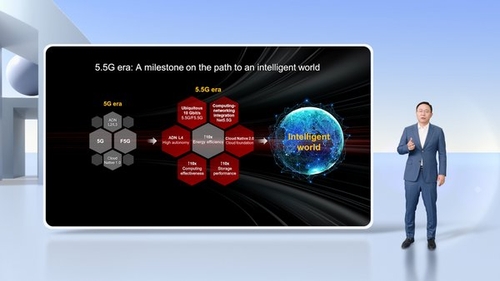[PRNewswire] Huawei: 5.5G is a key milestone on the path to an intelligent
전체 맥락을 이해하기 위해서는 본문 보기를 권장합니다.
Wang noted, "We must continue to work hard if we hope to reach an intelligent world. The 5.5G era is an important milestone on this path - one we cannot miss. In the 5.5G era, we will need ubiquitous 10 Gbit/s experience; intelligent and high-quality compute scheduling; highly autonomous L4 networks; Cloud Native 2.0 services for enterprises, and a 10-fold increase of computing effectiveness, storage, and infrastructure energy efficiency."
이 보도자료는 자료 제공사에서 제공한 것으로, 연합뉴스는 내용에 대해 어떠한 편집도 하지 않았으며, 연합뉴스의 편집방향과는 무관함을 밝혀 드립니다.
이 글자크기로 변경됩니다.
(예시) 가장 빠른 뉴스가 있고 다양한 정보, 쌍방향 소통이 숨쉬는 다음뉴스를 만나보세요. 다음뉴스는 국내외 주요이슈와 실시간 속보, 문화생활 및 다양한 분야의 뉴스를 입체적으로 전달하고 있습니다.

world
-- Striding Towards the Intelligent World White Paper Release
(BANGKOK, Sept. 21, 2022 PRNewswire=연합뉴스) The Striding Towards the Intelligent World Summit at HUAWEI CONNECT 2022 successfully concluded today. David Wang, Huawei's Executive Director of the Board and Chairman of ICT Infrastructure Managing Board delivered a keynote speech titled Embracing the 5.5G Era: Striding Towards the Intelligent World at this summit.
In this speech, he stressed that 5.5G is a key milestone on our path to an intelligent world and released Huawei's latest series of white papers on the intelligent world. Wang also called upon the ICT industry to coordinate efforts around eight facets of this vision. By working together to further define and refine the industry vision and standards for the 5.5G era, the industry will move ever faster towards the 5.5G era and the intelligent world.
In the future, individuals, households, and industries will have higher requirements for digital infrastructure.
For individuals, immersive services like XR and holographic communication are maturing, and connectivity experience is set to increase from 1 Gbit/s to 10 Gbit/s. Mobile DOU will surge from today's 15 GB to 100 GB. Requirements for latency and ubiquitous connectivity will also increase.
For households, the demands generated by advanced services like 24K 3D VR games and holographic education and meetings are creating a full-fiber, 10 Gbit/s era.
For industries, digital transformation has now entered the fast lane. Industrial-grade applications such as smart manufacturing and power grid dispatching are raising diversified requirements for connections, quality, and sensing, while also triggering explosive growth in demand for computing power and storage.
Wang noted, "We must continue to work hard if we hope to reach an intelligent world. The 5.5G era is an important milestone on this path - one we cannot miss. In the 5.5G era, we will need ubiquitous 10 Gbit/s experience; intelligent and high-quality compute scheduling; highly autonomous L4 networks; Cloud Native 2.0 services for enterprises, and a 10-fold increase of computing effectiveness, storage, and infrastructure energy efficiency."
He went on to highlight Huawei's belief that it will need the support of customers, ecosystem partners, industry organizations, and academic institutions to continue evolving and reinforcing digital infrastructure, thereby accelerating the advent of the 5.5G era and intelligent world.
More specifically, he said that industry players would have to come together to:
1. Promote the allocation of more spectrum to accelerate industry development and continue exploring new 5.5G use cases with greater commercial value;
2. Define the technical paths forward and standards for F5.5G;
3. Quickly reach a consensus on evolution towards Net5.5G;
4. Define a profile for L4/L5 autonomous networks and promote unified standards;
5. Build an open and diversified computing industry for shared success and redefine the computing architecture;
6. Define a storage architecture that meets diversified data processing requirements;
7. Build a cloud foundation for the intelligent world and cultivate a stronger cloud service industry ecosystem; and finally
8. Adopt a unified NCIe system to help industry save energy and reduce emissions with innovative ICT technologies and solutions.
Wang also released Huawei's latest series of white papers, which are titled Striding Towards the Intelligent World. Guided by the next steps relating to the eight facets mentioned above, these white papers explore both the opportunities and challenges that will be presented to major ICT infrastructure domains by emerging business needs and technological developments. The white papers also outline key trends in these domains and specify actions that the company recommends the industry should take before 2025.
Huawei's Chief Strategy Architect Dang Wenshuan then took the stage to discuss the contents of the white papers in more detail. He emphasized two concepts the company would like to promote as we move towards 5.5G and eventually the intelligent world:
1. "ICT for Intelligence" which focuses on constant innovation and evolution in different ICT domains to improve key capabilities, and
2. "Intelligence for ICT" which focuses on the intelligent and architectural innovation within the ICT industry itself that will be needed to address challenges like increasingly complex O&M, ensuring user experience in diversified service scenarios, and green development. Addressing these challenges will help us make the most of existing and coming core ICT capabilities and lead us to the intelligent world faster.
Source: Huawei Connect
[편집자 주] 이 보도자료는 자료 제공사에서 제공한 것으로, 연합뉴스는 내용에 대해 어떠한 편집도 하지 않았으며, 연합뉴스의 편집방향과는 무관함을 밝혀 드립니다.
(끝)
출처 : PRNewswire 보도자료
Copyright © 연합뉴스 보도자료. 무단전재 및 재배포 금지.
- 하마스, 이집트·카타르 휴전안 수용…"이스라엘은 동의 안해"(종합3보) | 연합뉴스
- '의대 증원' 법원 자료제출 앞두고 의·정 회의록 공방 지속 | 연합뉴스
- 박찬대 "정치검찰 사건조작 심각한 문제…특검 여부 충분 검토" | 연합뉴스
- 尹 2주년 회견에 與 "국민소통 의지" 野 "특검법 수용해야"(종합) | 연합뉴스
- '金값된 김값'…월평균 도매가 80% 치솟아 1만원 첫 돌파 | 연합뉴스
- 공무원 등 특수직역연금 평균수급액, 국민연금보다 5.5배 많아 | 연합뉴스
- 서울 교사 10명 중 7명 "악성민원 대응체계 부족" | 연합뉴스
- 푸틴, 오늘 5번째 '대관식'…2030년까지 러 대통령으로 | 연합뉴스
- 마크롱·시진핑·EU수장 3자회담서 통상마찰 '신경전'(종합2보) | 연합뉴스
- IMF 총재 "美, 올해 인플레 잡고 금리인하…재정 지출 신중해야"(종합) | 연합뉴스